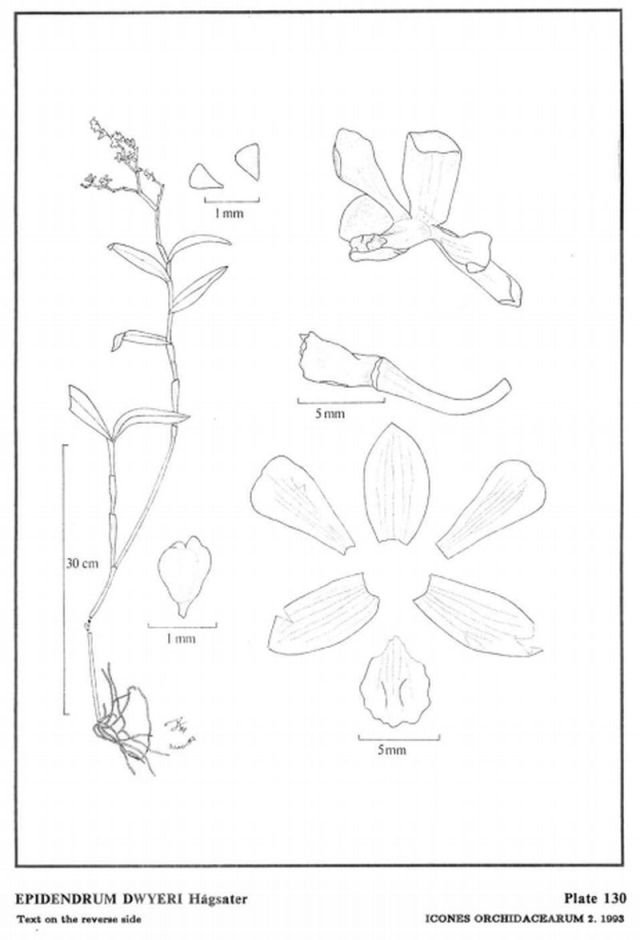

Epidendrum dwyeri Hágsater 1993 GROUP Neowilliamsia
TYPE Drawing by © Jimenez, Hágsater & E.Santiago and The AMO Herbario Website



Common Name or Meaning Dwyer's Epidendrum [American collector of species and Curator Emeritus at Missouri Botanical Gardens early 2000's]
Flower Size .8" [2 cm]
Found in Panama in cloud forests at elevations around 1500 to 1900 meters as a large sized, cool growing epiphyte with branching, cane-like, erect, arcuate to straight, laterally compressed, producing new stems from a middle internode of the previous stem carrying 2 to 5, along the apical 1/4 of the stem, elliptic, acute leaves that blooms in the summer on a terminal, on a mature stem, occuring only once, paniculate, flexuous, ancipitose rachis, 4 to 8" [10 to 20 cm] long including the peduncle, simultaneously 8 to 26 flowered inflorescence with each node covered by a conduplicate, triangular, acute bract and carrying flowers that probably are non-resupinate with the tepals tan-chocolate and the lip is white.
"Epidendrum dwyeri belongs to the GROUP Neowilliamsia characterized by the ancipitous stems and rachis with conduplicate, acute bracts and usually non-resupinate flowers with an often digitate lip and has 2 pollina with 2, hard, laminar caudicles. The suborbicular lip with sinuate apical margin and the spatulate, truncate-rounded petals easily identify this species. Epidendrum dwyerioides Hágsater & E.Santiago is recognized by the paniculate inflorescence with greenish yellow flowers with brown spots, a very reduced subentire, white lip with a pair of trangular lateral lobes, the nectary wide in front of the stigmatic cavity and narrow at the bottom. The habit is somewhat similar to E. wercklei Schltr., but this species has spotted flowers and a deeply fimbriate lip." Hagsater 1993
Synonyms
References W3 Tropicos, Kew Monocot list , IPNI ; * Icones Orchidaceaerum 2 Plate 130 Hagsater 1993 drawing fide; Icones Orchidacearum Vol 8 Plate 870 Hagsater & Sanchez 2006 see recognition section; Icones Orchidacearum 9 Plate 925 Hagsater 2007 see recognition section; Icones Orchidacearum 9 Plate 929 Hagsater 2007 see recognition section; Icones Orchidacearum 9 Plate 989 Hagsater 2007 see recognition section;
--------------------------------------------------------------------------------------------------------------------------